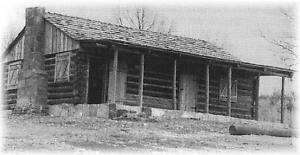Flint Courthouse
category : Historic Courthouses
 In 1840, when the Western Cherokee Nation was organized, there were nine districts created. Flint and Goingsnake were two districts located in what is now the Adair County area. Flint was the smallest of these districts. Since log houses were the standards of that day and time, the various courthouses were of log construction. As to when and where the original log building was built in the Flint District is not known, in 1880, the Cherokee government appropriated $1200 for each district to replace their courthouses. So at Flint, a new courthouse was constructed. This one was a large two-story frame building and was painted white. The first floor had two rooms. Behind the entrance hall, which held two stairways, led to the large courtroom, on the second floor. Two large stone constructed chimneys were on each end of the building, servicing four fireplaces (two on each floor.)
In 1840, when the Western Cherokee Nation was organized, there were nine districts created. Flint and Goingsnake were two districts located in what is now the Adair County area. Flint was the smallest of these districts. Since log houses were the standards of that day and time, the various courthouses were of log construction. As to when and where the original log building was built in the Flint District is not known, in 1880, the Cherokee government appropriated $1200 for each district to replace their courthouses. So at Flint, a new courthouse was constructed. This one was a large two-story frame building and was painted white. The first floor had two rooms. Behind the entrance hall, which held two stairways, led to the large courtroom, on the second floor. Two large stone constructed chimneys were on each end of the building, servicing four fireplaces (two on each floor.)The location of the Flint courthouse and the town of Mays was on the banks of the Sallisaw Creek in Section 10, T-15-N, R-25-E, of what is now Adair County. It was located on the "Old Military Road" from Fort Smith, Arkansas to Fort Gibson, I.T. There was also another road up the Sallisaw Creek to Evansville, Arkansas.
Many important trials, both civil and criminal cases. were disposed of at the Flint Courthouse during the days when the laws of the Cherokee Nation prevailed. Crimes, involving Cherokee versus Cherokee, were under the jurisdiction of the Cherokee courts; whereas, cases or crimes committed by Indians versus white, were handled by the United States Court at Fort Smith, Arkansas.
In 1894, when the Kansas City and Pittsburgh Railway Company was making plans to continue the route from Siloam Springs further south, the engineers were sent to survey and establish the route for the new railroad. A new president, Arthur Stilwell, made different plans to establish the new division point to be three and one-half miles north of Mays. The trade center a Mays was "doomed to oblivion." In 1902, the federal courts ended the authority of the Cherokee government. The old Flint court in Mays was sold, dismantled and used to build a hotel in Stilwell.
In 1977, the Adair County Historical Society appealed to the Oklahoma State Legislature for a grant to build a memorial structure to be built on the site of the old Flint courthouse. A log structure, conforming closely to those of the era of the 1800s, was built. It was located on the exact site of the former courthouse. Today, the Cherokee Nation retains the ownership of this property and at the present time, it is badly in need of repairs.
Come visit us in Stilwell, Oklahoma